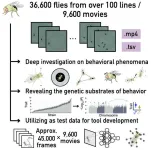Unlocking the genetic basis of animal behavior using fruit flies
A comprehensive dataset captures individual and group behaviors across genetically diverse strains of flies for decoding animals’ behavioral patterns
2025-04-14
(Press-News.org)
Years of research in the field of genetics have offered interesting insights spanning the origins and development of heredity and traits, offering valuable information on its influence on every aspect of life, right from eye color to susceptibility to certain diseases. But how do our genes influence the way we act, react to threats, and interact with others? Despite the recent advances in genetics, understanding the genetic foundations of behavior remains one of biology’s most fascinating challenges. Scientists have long turned to simpler organisms to help answer these questions, with the humble fruit fly emerging as an ideal candidate. These tiny insects share many genes with humans that are linked to various diseases, making them valuable models for understanding the relationship between genetics and behavior. Moreover, their short lifespan, ability to reproduce quickly, and produce numerous offsprings also allows researchers to conduct large-scale studies in a cost-effective manner.
However, creating meaningful connections between genes and behavior requires extensive, high-quality data, as this data needs to capture a wide range of behavioral patterns under various conditions. Against this backdrop, a research team led by Assistant Professor Daiki Sato, along with Mr. Takahira Okuyama and Associate Professor Yuma Takahashi from Chiba University, Japan, has now compiled an unprecedented behavioral dataset of Drosophila melanogaster. Their study, published in Volume 12 of Scientific Data on March 7, 2025, documents the behaviors of over 30,000 individual D. melanogaster, commonly known as fruit fly, across 105 genetically distinct strains, including 104 wild-type strains and one visually impaired mutant.
The research team meticulously recorded the flies’ movements during 15-minute sessions in a confined space. The sessions included periods of normalcy and simulated threats in the form of looming stimuli—expanding dark circles that mimic approaching predators. Notably, the experiments were conducted with both isolated flies and flies in groups, allowing researchers to examine not only individual behaviors but also social interactions. In a particularly innovative approach, the team created mixed groups with flies from different genetic strains to investigate how genetic diversity might affect group dynamics.
Using sophisticated tracking software, the researchers quantified various behavioral metrics, including movement speed, time spent in the center of the arena (an indicator of boldness), distance to nearest neighbors (a measure of sociality and locomotor activity), and freezing duration (an indicator of the fear response) after exposure to threats. The resulting dataset provides a comprehensive catalog of behavioral responses categorized by genetic background, sex, and social context. Elaborating further, Dr. Sato says, “By documenting the variation in behaviors across different genetic and environmental contexts, we can expand our understanding of how genes, social environment, and individuality shape animal behavior.”
What makes this dataset especially valuable is its ability to support genome-wide association studies, which can help identify specific genetic variations associated with particular behavioral traits. Additionally, the inclusion of genetically identical flies enables researchers to examine behavioral variations arising from the same genetic background, also offering insights into the influence of non-genetic factors on behavior.
Worth noting, the implications of this research extend far beyond the domain of fruit flies. The methodology and findings used in this study could potentially inform studies of more complex animals, including humans, and contribute to our understanding of mental health conditions with known or suspected genetic components. This publicly available dataset also offers a valuable resource for the scientific community, enabling further analyses and discoveries across disciplines. As Dr. Sato notes, “Our dataset not only holds the potential for discovering and functionally analyzing causative genes involved in diverse behavioral patterns, but it can also drive the development of image analysis and tracking software.”
By bridging the gap between genetics and behavior, efforts could pave the way for research that ultimately leads to the development of mental health treatments, as well as a deeper understanding of how our genes influence our identity and behavior.
About Assistant Professor Daiki Sato
Dr. Daiki Sato is an Assistant Professor at the Graduate School of Science at Chiba University, Japan. His research focuses on evolutionary genomics and the genetics and molecular and ecological mechanisms behind emergent properties of collective behavior.
END
[Attachments] See images for this press release:

ELSE PRESS RELEASES FROM THIS DATE:
2025-04-14
DARIEN, IL — The American Academy of Sleep Medicine has released a new position statement emphasizing the clinical significance of sleepiness and its impact on performance, health, mood, safety, and quality of life.
The position states that sleepiness is a critical patient-reported outcome that is associated with an increased risk for adverse health effects and diminished quality of life. The statement urges health care professionals, policymakers, and researchers to prioritize the evaluation, management, and treatment of sleepiness ...
2025-04-14
A new USC study suggests that gut imbalances in children with autism may create an imbalance of metabolites in the digestive system — ultimately disrupting neurotransmitter production and influencing behavioral symptoms.
The research, published today in Nature Communications, adds to a growing body of science implicating the “gut-brain” axis in autism. The discovery raises the possibility of new treatment avenues. It’s an example of how research at USC, and other universities, drives ...
2025-04-14
A new study has shed unprecedented light on the highly variable and climate-sensitive routes that substances from Siberian rivers use to travel across the Arctic Ocean. The findings raise fresh concerns about the increasing spread of pollutants and the potential consequences for fragile polar ecosystems as climate change accelerates.
The international research, published today in Nature Communications and led by the University of Bristol, in the UK, provides the clearest ever picture of how the underlying transport system, known as the Transpolar Draft, operates. It also uncovers the various factors controlling this major Arctic surface current, ...
2025-04-14
An international team of researchers may have answered one of space science’s long-running questions – and it could change our understanding of how life began.
Carbon-rich asteroids are abundant in space yet make up less than 5 per cent of meteorites found on Earth.
An international team of scientists from Curtin University’s School of Earth and Planetary Sciences, the International Centre for Radio Astronomy (ICRAR), the Paris Observatory and more scoured the globe to find an answer.
Published today in Nature Astronomy, researchers analysed close to 8500 meteoroids and meteorite impacts, using data from ...
2025-04-14
Statement Highlights:
While the strongest evidence exists that getting sufficient sleep (duration of sleep) is important for overall health , other components of sleep health, such as consistent bedtime, uninterrupted sleep, daytime functioning and self-reported sleep satisfaction, also contribute to cardiometabolic health and related risk factors, including heart disease, stroke, high blood pressure, high cholesterol, inflammation, glucose intolerance, obesity and obstructive sleep apnea.
Differences in sleep health may contribute to increased risk factors and worse health outcomes, particularly for people in under-resourced communities and individuals ...
2025-04-14
Researchers from the University of Birmingham have uncovered answers that provide the detail to explain two specific DNA repair processes that have long been in question.
The publication of two papers demonstrates how work led by laboratories from the Department of Cancer and Genomic Sciences, and School of Biosciences at the University of Birmingham has made strides in understanding how the repair process is correctly orchestrated.
The importance of understanding DNA repair
Our cells protect their DNA by constantly monitoring and repairing any damage. When DNA is damaged, internal signals activate within the cell to pinpoint the damage and recruit specialised proteins—DNA ...
2025-04-14
Microplastics and the much smaller nanoplastics enter the human body in various ways, for example through food or the air we breathe. A large proportion is excreted, but a certain amount remains in organs, blood and other body fluids. In the FFG bridge project Nano-VISION, which was launched two years ago together with the start-up BRAVE Analytics, a team led by Harald Fitzek from the Institute of Electron Microscopy and Nanoanalysis at Graz University of Technology (TU Graz) and an ophthalmologist from Graz addressed the question of whether nanoplastics also play a role in ophthalmology. The project partners have now been able to develop a method for detecting and quantifying nanoplastics ...
2025-04-14
Rates of colorectal cancer (CRC) diagnoses dropped during and shortly after Hurricanes Irma and Maria and the COVID-19 pandemic in Puerto Rico, according to a recent analysis. However, late-stage diagnoses eventually exceeded expectations, suggesting that limited access to cancer screening services due to these disasters likely hindered timely CRC diagnoses. The findings are published by Wiley online in CANCER, a peer-reviewed journal of the American Cancer Society.
During disasters, medical services may be delayed or inaccessible due to damaged infrastructure, overburdened health ...
2025-04-14
Sleep is a necessary part of people’s daily routine, but modern lifestyles and technology have ushered in an era of decreased rest time and subsequent fatigue. Further, the bedroom environment, such as light, sound, and temperature, is important for a good night's sleep, though this is often neglected in residential architecture.
In search of a conclusive remedy, common sleep studies use artificial light that is easy to control. Osaka Metropolitan University researchers, however, believe natural light could be more effective for re-creating actual living environments.
To test this, Graduate School of Human Life and Ecology student Xiaorui Wang and Professor ...
2025-04-14
Farmers in dozens of countries have embraced crops genetically engineered to produce proteins from Bacillus thuringiensis (Bt) bacteria that kill some key pests yet are safe for people and wildlife. Although this biotech approach reduces reliance on insecticide sprays thereby providing economic and environmental benefits, resistance to Bt crops has evolved in at least 11 species of pests. Thus, effective ways to combat such pest resistance are urgently needed.
A new study published in the Proceedings of the National Academy of Sciences identifies a natural strategy for thwarting pest resistance to Bt proteins. The researchers at the University of Arizona and ...
LAST 30 PRESS RELEASES:
[Press-News.org] Unlocking the genetic basis of animal behavior using fruit flies
A comprehensive dataset captures individual and group behaviors across genetically diverse strains of flies for decoding animals’ behavioral patterns




